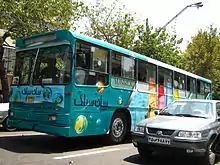Environmental issues in Iran
Environmental issues in Iran include, especially in urban areas, vehicle emissions, refinery operations, and industrial effluents which contribute to poor air quality. Most cars use leaded gas and lack emissions control equipment.[1] Tehran is rated as one of the world's most polluted cities. However, buses and cars running on natural gas are planned to replace the existing public transportation fleet in the future. Also, energy prices are kept artificially low in Iran through heavy state subsidies, resulting in highly inefficient and polluting consumption patterns.[2][3] Traffic management, vehicle inspection, general use of electric bicycles and electronic government are also part of the solution.[4]

A rising incidence of respiratory illnesses prompted the city governments of Tehran and Arak, southwest of the capital, to institute air pollution control programs. These programs aim to reduce gradually the amount of harmful chemicals released into the atmosphere.[5]

Much of Iran’s territory suffers from overgrazing, desertification and/or deforestation. Industrial and urban wastewater runoff has contaminated rivers, coastal and underground waters.[6] Wetlands and bodies of fresh water increasingly are being destroyed as industry and agriculture expand, and oil and chemical spills have harmed aquatic life in the Persian Gulf and the Caspian Sea.[7] Iran contends that the international rush to develop oil and gas reserves in the Caspian Sea presents that region with a new set of environmental threats.[8] Although a Department of Environment has existed since 1971, Iran has not yet developed a policy of sustainable development because short term economic goals have taken precedence.[9]
The World Bank estimates losses inflicted on Iran's economy as a result of deaths caused by air pollution at $640 million, which is equal to 5.1 trillion rials or 0.57 percent of GDP.[10] Diseases resulting from air pollution are inflicting losses estimated at $260 million per year or 2.1 trillion rials or 0.23 percent of the GDP on Iran's economy. A report by the United Nations Environment Programme ranked Iran at 117th place among 133 countries in terms of environmental indexes.[11][12]

Major Environmental Agreements
- Party to: Biodiversity, Kyoto Protocol on climate change but not its Doha Amendment,[13] Desertification, Endangered Species, Hazardous Wastes, Marine Dumping, Ozone Layer Protection, and Wetlands.[14]
- Signed, but not ratified: Environmental Modification, Law of the Sea, Marine Life Conservation,[14] and Paris Agreement on climate change. [15]
Natural hazards: periodic droughts, floods; dust storms, sandstorms; earthquakes along western border and in the northeast.[14]
Environment – current issues: air pollution, especially in urban areas, from vehicle emissions, refinery operations, and industrial effluents; deforestation; overgrazing; desertification; oil pollution in the Persian Gulf; wetland losses from drought; soil degradation (salination); inadequate supplies of potable water; water pollution from raw sewage and industrial waste; urbanization.[14] Iran ranked worst in the world for soil erosion in 2011.[16] Iran had a 2018 Forest Landscape Integrity Index mean score of 7.67/10, ranking it 34th globally out of 172 countries.[17]
Garbage/waste disposal: An estimated 50,000 tons of trash is produced in the country every day of which something between 70 and 80 percent is disposed of hygienically but the rest is not.[18] Iran produces over 8 million tons of hazardous waste annually (2016).[19]
See also
References
- Iran Daily – Domestic Economy – 07/01/07 Archived 2008-05-06 at the Wayback Machine
- "Atieh Bahar". 28 September 2007. Archived from the original on 2007-09-28.
- "Archived copy". Archived from the original on 2009-03-18. Retrieved 2016-02-19.CS1 maint: archived copy as title (link)
- "YouTube". www.youtube.com.
- "Iran Pharmaceuticals and Healthcare Report Q2". www.payvand.com.
- "Archived copy". Archived from the original on 2009-09-12. Retrieved 2009-09-11.CS1 maint: archived copy as title (link)
- "Iran – Country Brief". web.worldbank.org.
- "Iran environment in grave danger". www.payvand.com.
- "Green Party of Iran – News". www.iran-e-sabz.org.
- "Archived copy". Archived from the original on 2007-11-15. Retrieved 2015-11-22.CS1 maint: archived copy as title (link)
- Iran Daily – Front Page – 03/06/07
- "Iran Environment in Grave Danger". www.payvand.com.
- "United Nations Treaty Collection". treaties.un.org. Retrieved 2020-11-10.
- "Archived copy". Retrieved 2012-12-04.
- "United Nations Treaty Collection". treaties.un.org. Retrieved 2020-11-10.
- "Iran ranked worst in the world for soil erosion: expert". www.payvand.com.
- Grantham, H. S.; Duncan, A.; Evans, T. D.; Jones, K. R.; Beyer, H. L.; Schuster, R.; Walston, J.; Ray, J. C.; Robinson, J. G.; Callow, M.; Clements, T.; Costa, H. M.; DeGemmis, A.; Elsen, P. R.; Ervin, J.; Franco, P.; Goldman, E.; Goetz, S.; Hansen, A.; Hofsvang, E.; Jantz, P.; Jupiter, S.; Kang, A.; Langhammer, P.; Laurance, W. F.; Lieberman, S.; Linkie, M.; Malhi, Y.; Maxwell, S.; Mendez, M.; Mittermeier, R.; Murray, N. J.; Possingham, H.; Radachowsky, J.; Saatchi, S.; Samper, C.; Silverman, J.; Shapiro, A.; Strassburg, B.; Stevens, T.; Stokes, E.; Taylor, R.; Tear, T.; Tizard, R.; Venter, O.; Visconti, P.; Wang, S.; Watson, J. E. M. (2020). "Anthropogenic modification of forests means only 40% of remaining forests have high ecosystem integrity - Supplementary Material". Nature Communications. 11 (1): 5978. doi:10.1038/s41467-020-19493-3. ISSN 2041-1723. PMC 7723057. PMID 33293507.
- "Every Iranian produces 700 grams of garbage per day". www.payvand.com.
- "Hazardous Waste Production Alarming". 23 October 2016.
External links
- Department of Environment – Islamic Republic of Iran
- Environment in Iran – Brief Sector Study at the Wayback Machine (archived September 28, 2007) (2003)
- US Dept. of Energy – Environment Overview for Iran
- Iran: Environment and Nature
- First Iranian site covering environmental news
- Videos
- Iran's Environment in Danger – PressTV video (2010)
![]() This article incorporates public domain material from the Library of Congress Country Studies website http://lcweb2.loc.gov/frd/cs/.
This article incorporates public domain material from the Library of Congress Country Studies website http://lcweb2.loc.gov/frd/cs/.